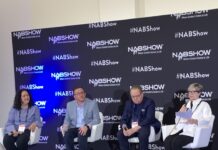
Broadcasters have been waiting to be able to make sales pitches to advertisers that include both over-the-air listening numbers and online listening numbers. That product is still in the hands of Nielsen and is very close to being rolled out, according to the ratings firm. Rob Kass is Nielsen’s Vice President for Digital Audio. We spoke with Kass about where the combined listening measurement stands as of today and we’ll be sharing that interview with readers over the next several days. Here’s part one of our interview.
RI: Tell us exactly where we are, what stage of the game we are in here?
Kass: We are, from a technology standpoint, essentially ready to go. We have station data coming in from more than 2,500 different stations. We’ve got pretty much all of the major vendors, like WideOrbit, Triton, Stream Guys, all of them have the SDK (Software Development Kit) in them. TuneIn has the SDK in them. In our internal software, the Tapscan software, stuff like that that the clients are used to using, that’s all set up and ready to go. In fact we’re using that data internally to take a look at the numbers and share that data with clients. The piece that we’re waiting for, really, is the debate around the reporting world and how things get displayed. There is no real disagreement in the industry around total line reporting for 100% simulcasts. Just like it is today, in the traditional world, or whatever we want to call it, where if you are 100% simulcast, content and ads, you can combine that together with the listening that’s happening in the home markets. We would plan on doing the exact same thing with the SDK measurement. The industry seems pretty aligned with that. Where there is still a bit of debate, between the broadcasters and the agencies, is basically around three things. One is, what happens when the ad load is different. Should you be able to combine that? The second one is should you be able to see the contribution of digital to that total line number, that combo number so that when you see a big number, how much of that is from your traditional over-the-air and how much of that was from your digital stream. The third is, what is the appropriate metric for a digital pure play. Is it audience impressions? Should it be average quarter hour. This is where we continue to work with the industry to get them to have some productive discussions, to get the MRCs viewpoint so that we can get a good understanding on what metrics are going to matter and are important to the industry. This has been dragging out for quite some time. We’ve made it known over the last month or so that we’re not going to let this drag on forever, and if need be, at some point, and I don’t have a date, we will make a decision if need be. We can’t let this continue to drag on and on. Since we’ve been a little more aggressive in that stance, the industry had come back to us and said “Give us a little bit more time to delve into some of these topics.” So that’s what we’ve let them do over the last couple of weeks or so. I feel pretty positive in the progress that they’re making. Has it dragged on longer than I would like it to? Absolutely. But, I think everybody involved is starting to see light at the end of the tunnel.
RI: Is it the pure plays and the broadcasters that can’t come to an agreement on the metric?
Kass: We want to hear from the agencies. Ultimately, they are the ones that are going to be using this data to negotiate between the advertisers and the broadcasters. We have yet to hear from them with a consolidated viewpoint. We’ve heard bits and pieces here and there. There’s still not alignment. Whether that’s on being able to combine different ad load content with broadcast over-the-air, or if it’s the breakout of digital contribution to the number, or the digital pure play. Depending on who you talk to, within in each group, agencies or the stakeholder groups, there’s a lack of consensus. Everybody feels very good about the progress in the last couple of weeks, but we have yet to see a definitive, here’s what we want from the agencies and from the broadcasters as a whole. While that’s been going on, and I think this is a really important point to make, we’ve continued to move forward on the technology piece, getting the SDK out there and getting the TuneIn platforms all wired up. We are already looking into if we need to expand it to the diary market. We are starting to look at how you measure podcasting and on-demand content and all of that. We are not letting this reporting thing stop us from that. Once we get that go-ahead from the industry, we will be ready to go from a technology standpoint. Going back to your original question, what that looks like is, from a technology standpoint, we are ready to go, as soon as we get that reporting go-ahead, then we will launch a preview period, which will last two radio-survey periods. During that time, again, clients can see their own data, ask questions, that sort of thing. At the end of that two-survey period preview, we would then require clients to subscribe in order to continue to see the data. At that point, once they are a subscriber, not only will they see their own data, but they will also see other subscribing clients’ data. If we were to get that reporting decision today, then depending on when the survey period would start, it would be two survey periods and then we would be officially launched.
RI: If I’m in a GM and I subscribe, am I going to see Pandora’s numbers next to my numbers?
Kass: Currently we are not measuring Pandora. Obviously they are getting measured though other providers out there in the marketplace. The first phase that Nielsen is doing for digital audio is really focused on those digital streams of the local radio broadcast. In 2016 we will start, and we’ve already started some conversations around what we’re calling customized listening, like the Pandora’s and the Spotify’s and those things, as well as on-demand content. We will measure that in 2016. Eventually, if everybody is all measured up and clients are subscribing, we would see all of that data in the same system. But, there are several things, first of all, you’ve got to get the SDK in there in order to be able to measure it, because otherwise you’re not comparing apples to apples. If another company has a measurement out there for a Pandora, and you’re trying to compare that to an SDK metric for one of the radio broadcasters, it’s not going to be the same thing. They’re using different methodology, where we are using the SDK and we’re providing demographics as well.
We’ll have more from Kass in our morning headlines tomorrow.





